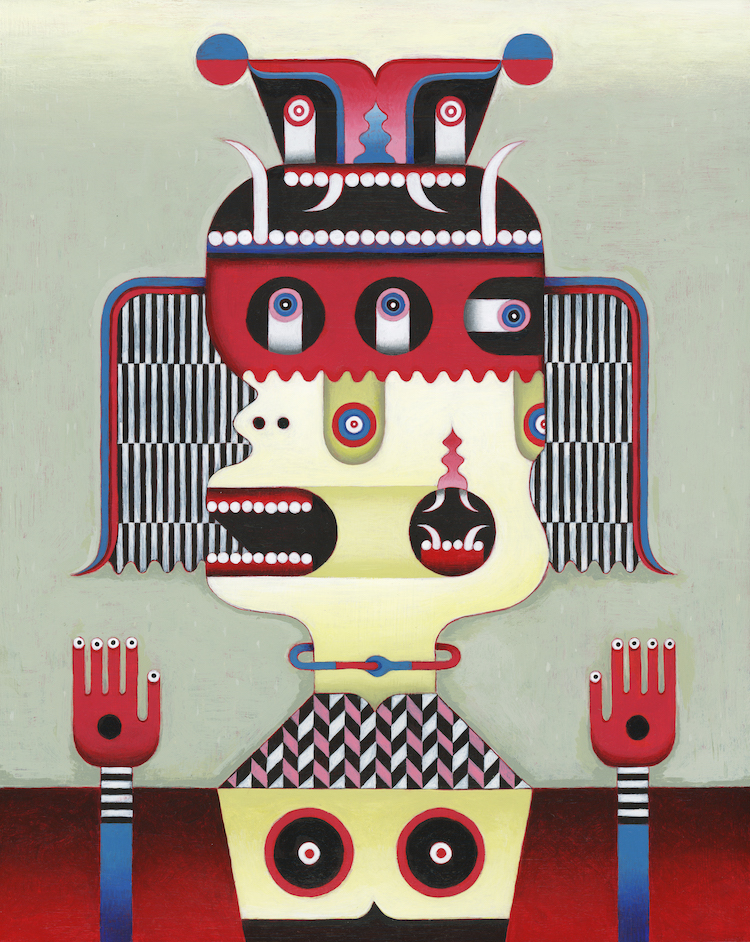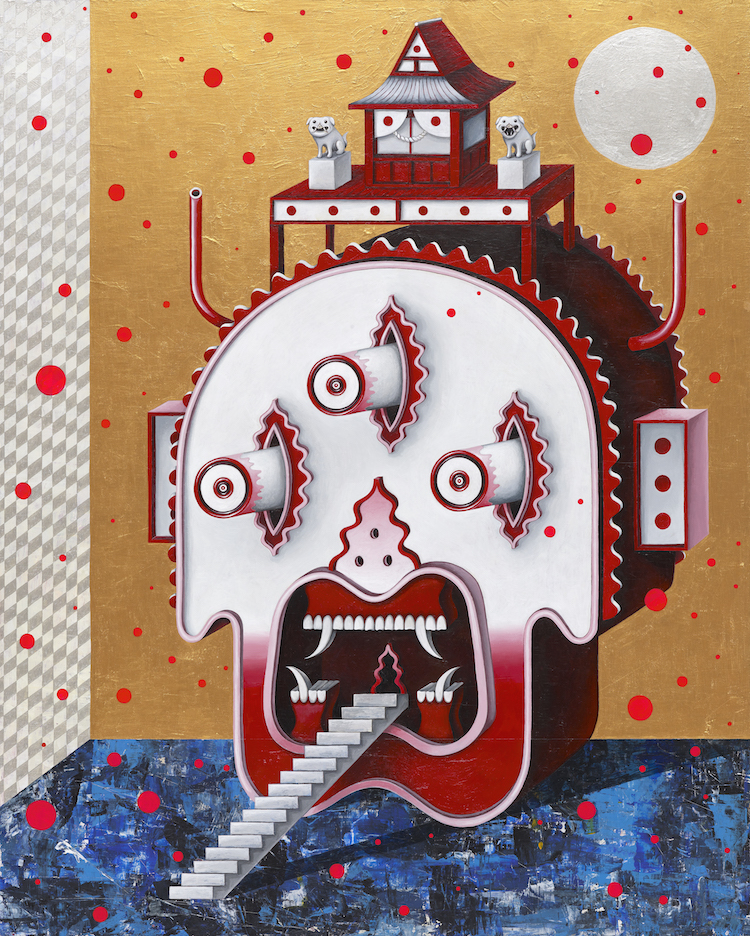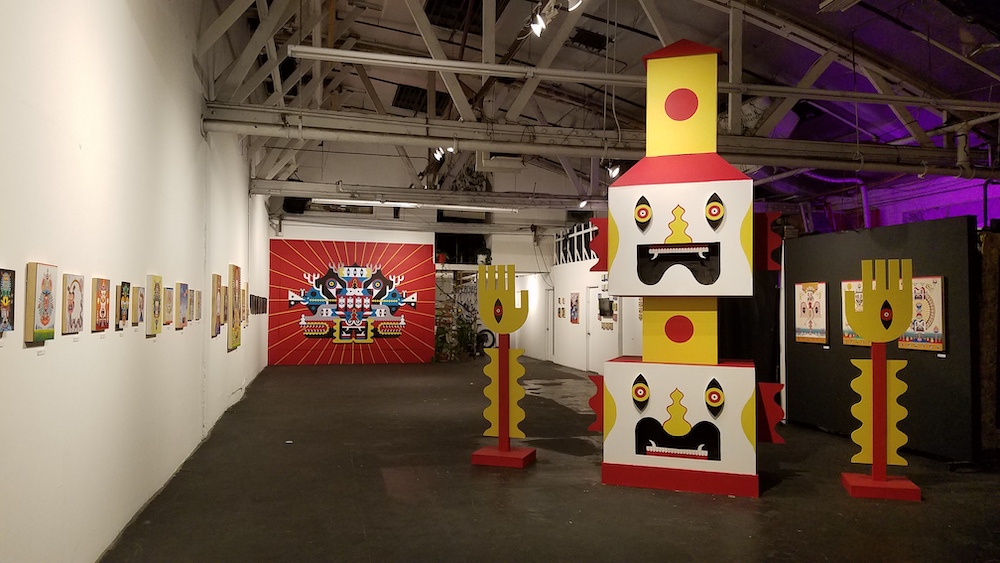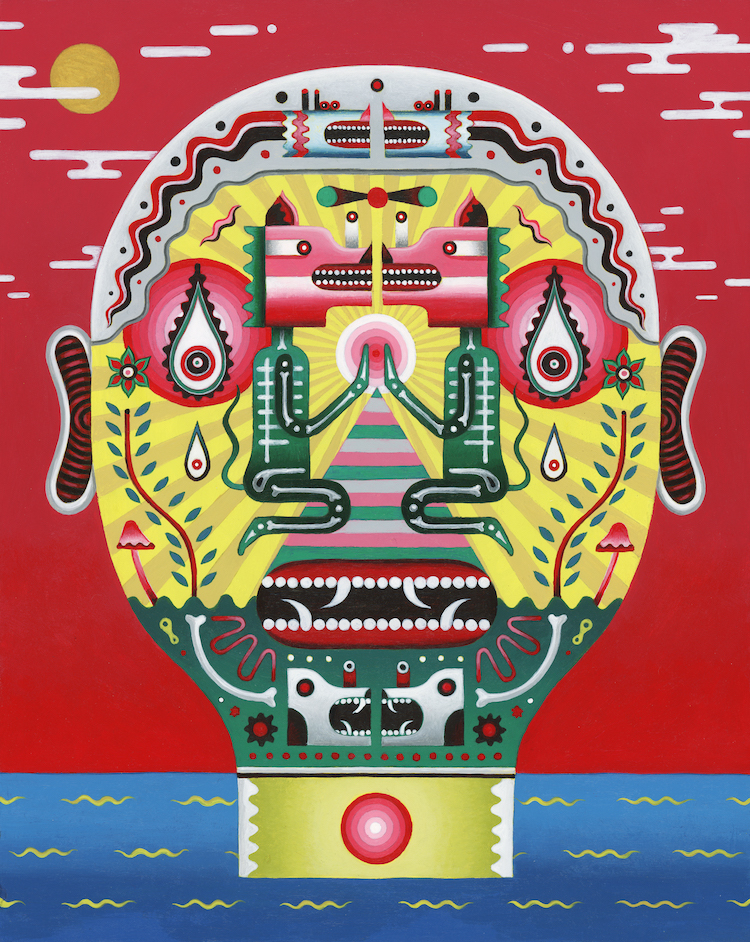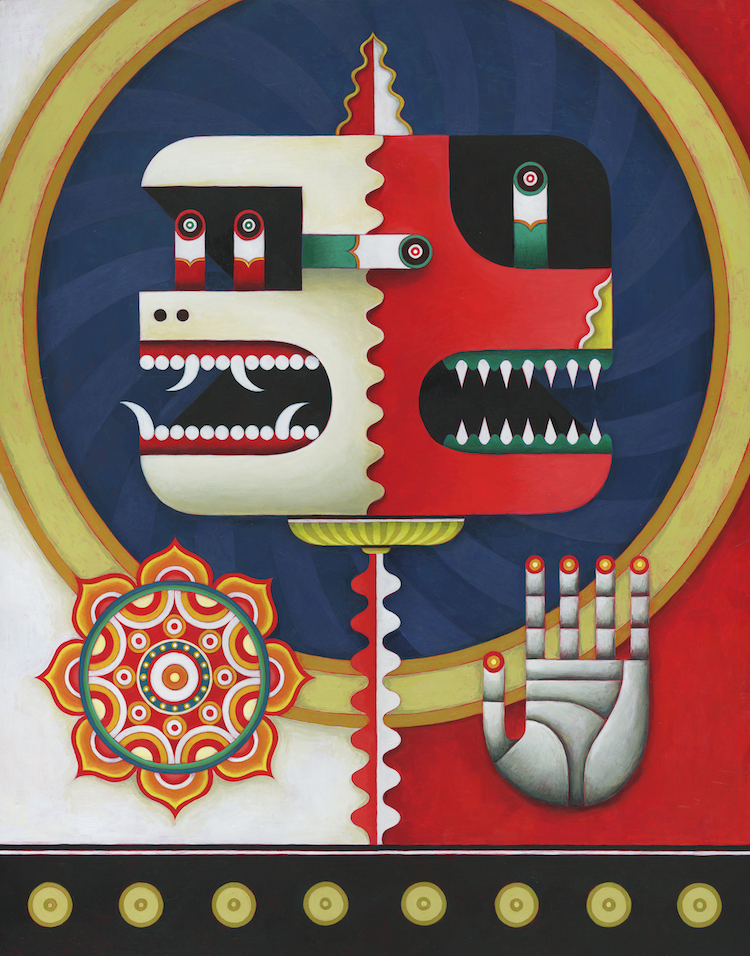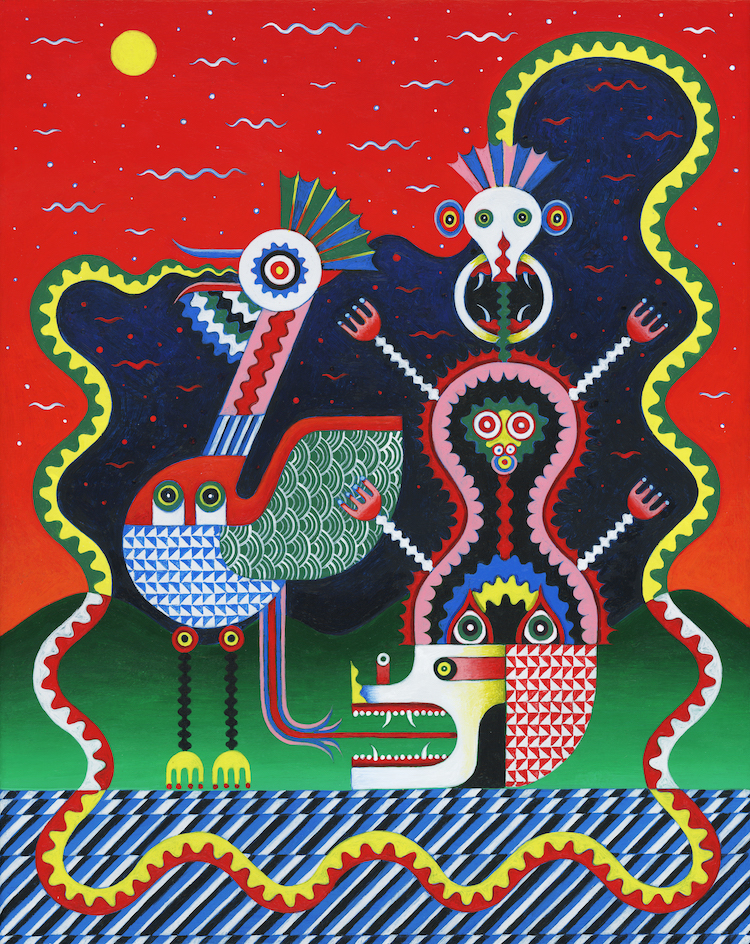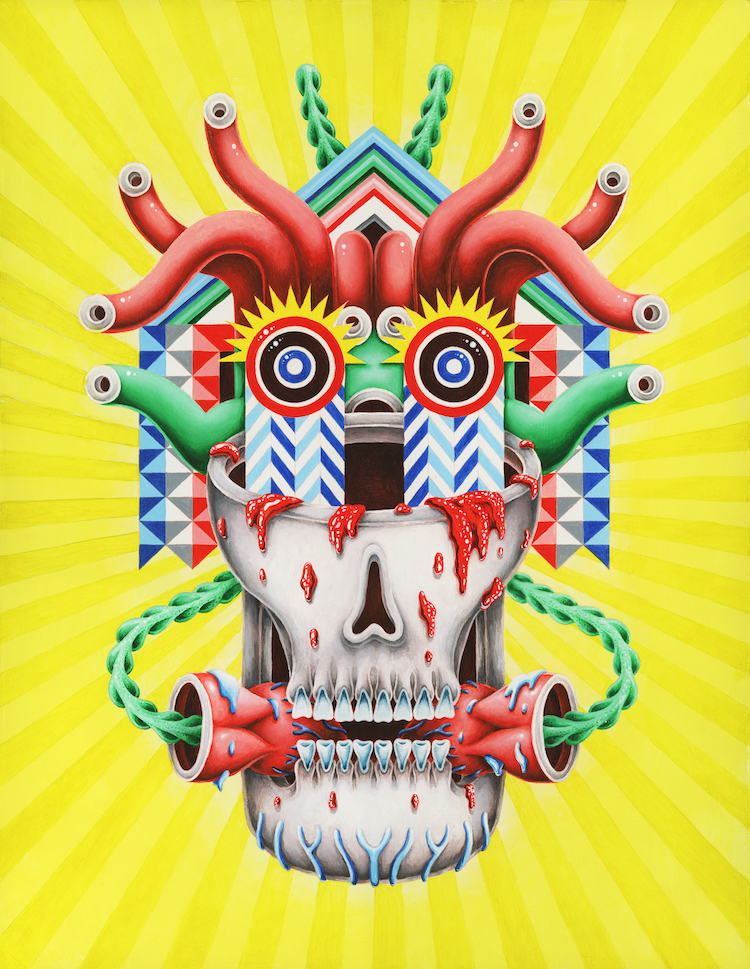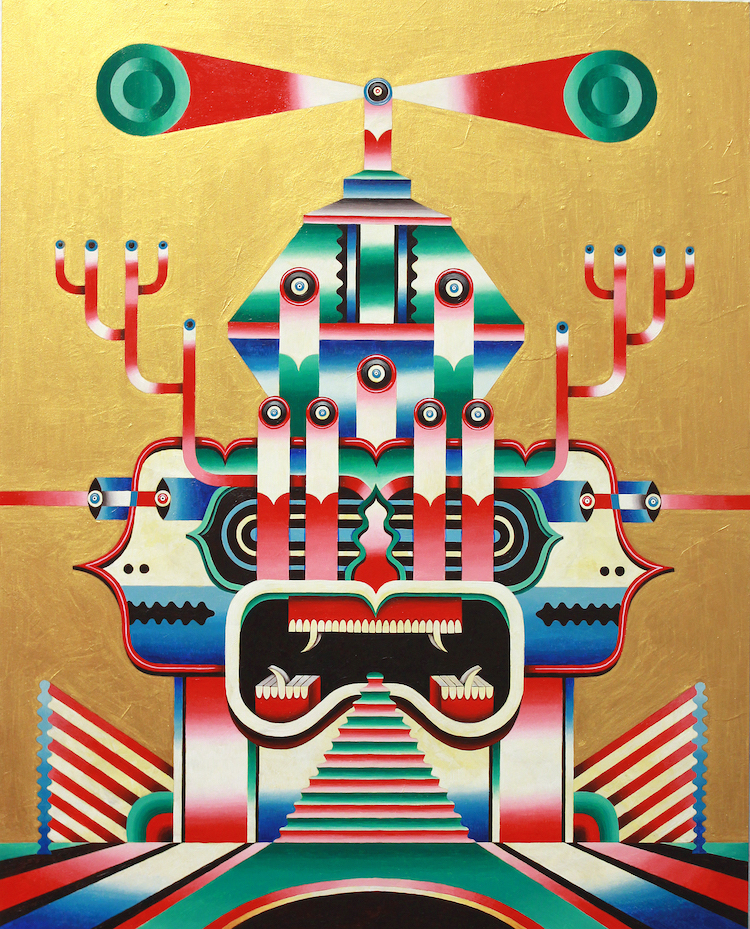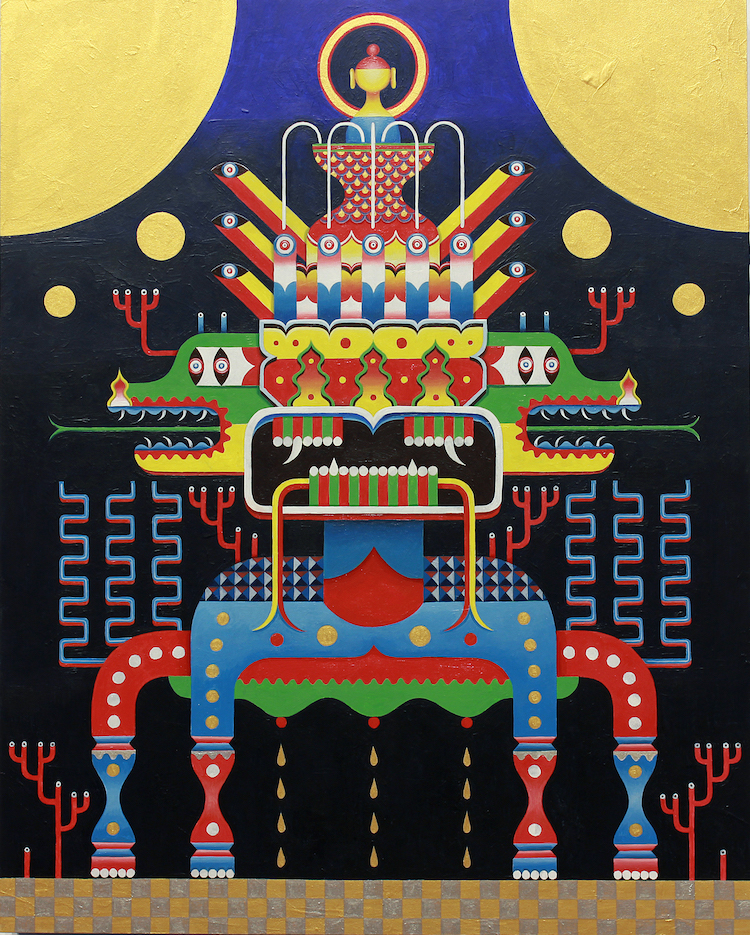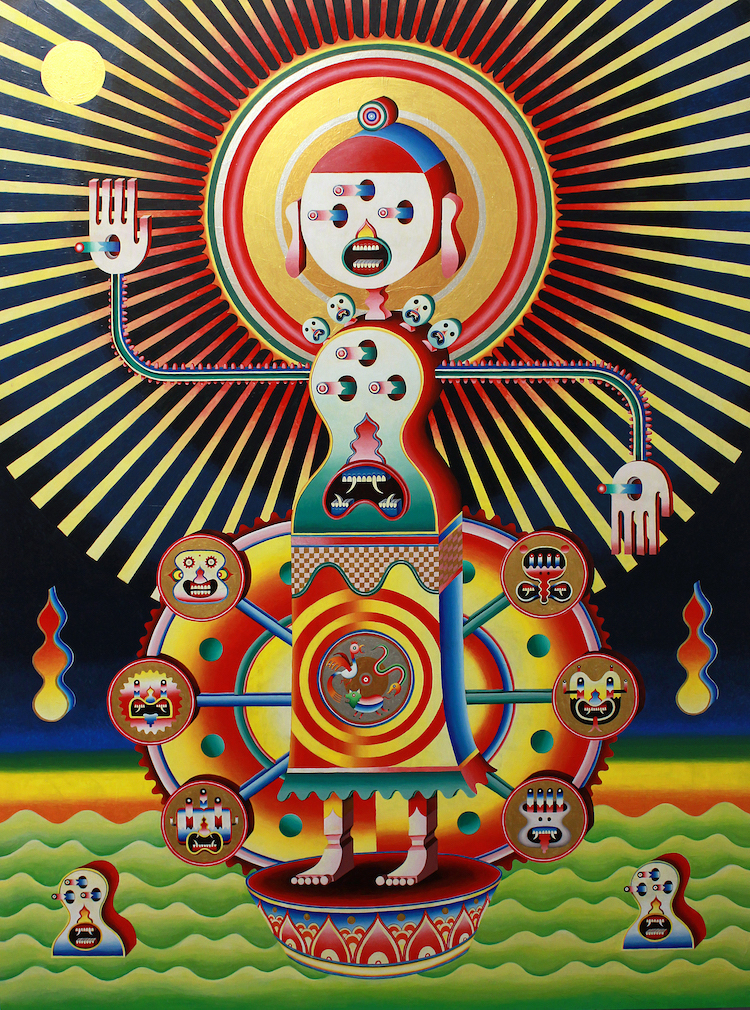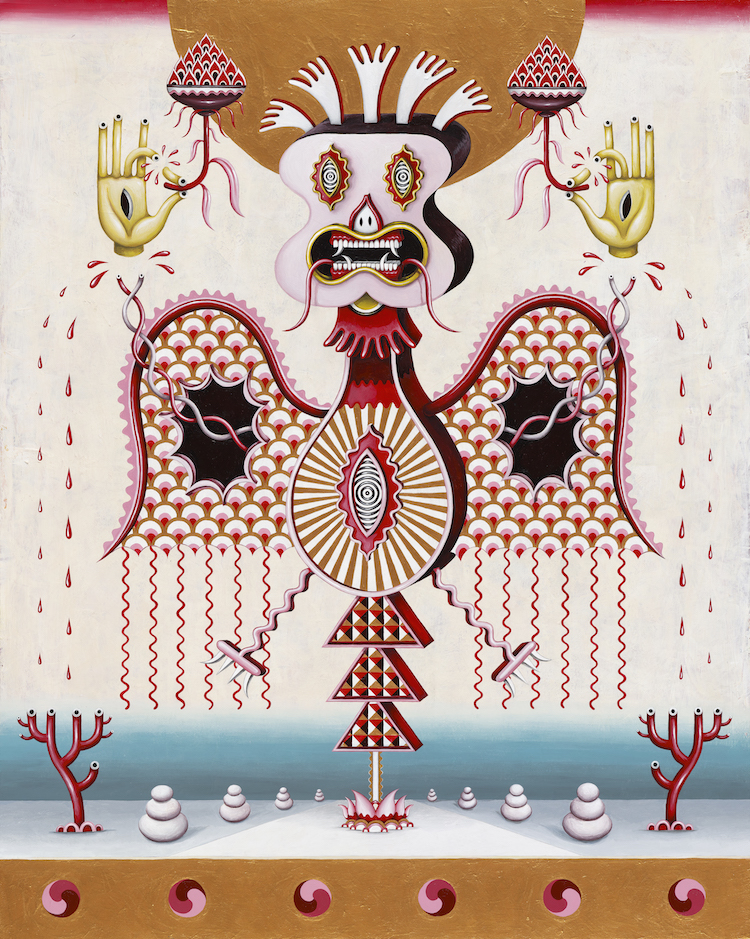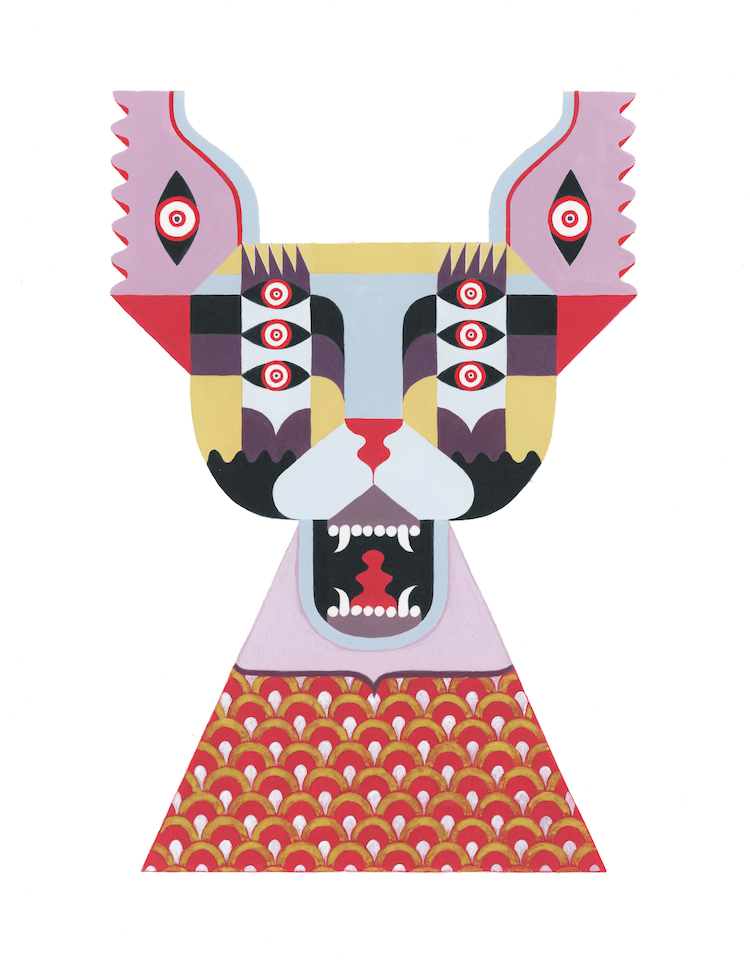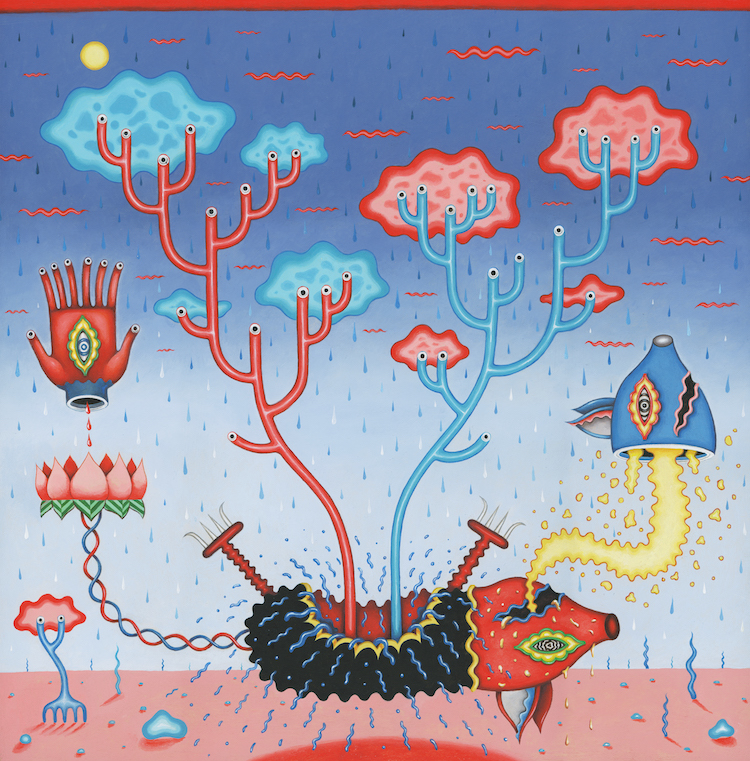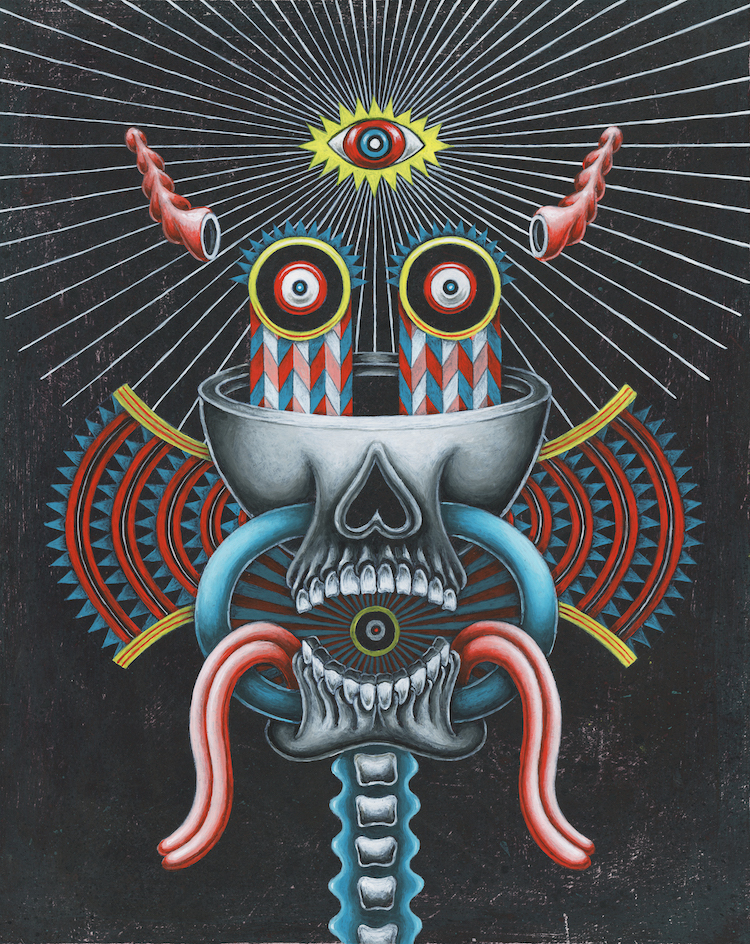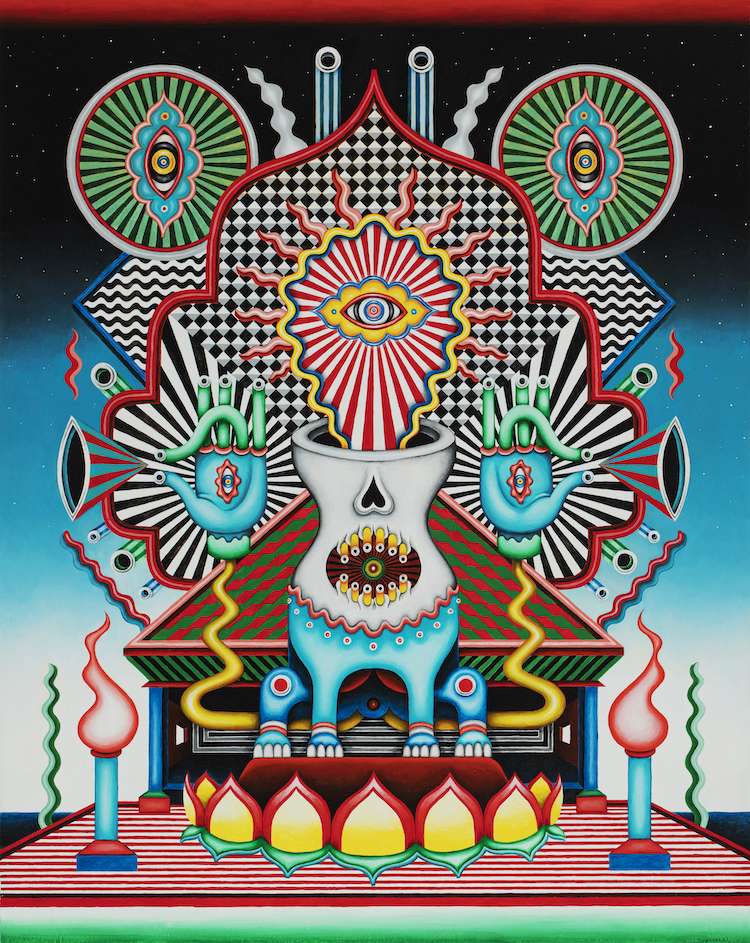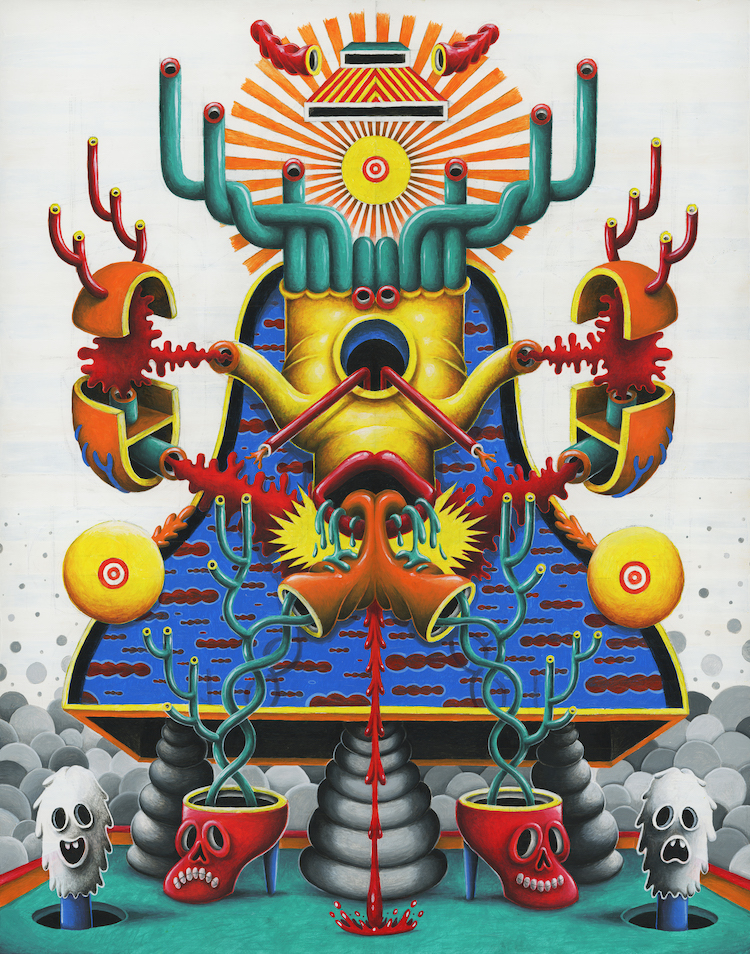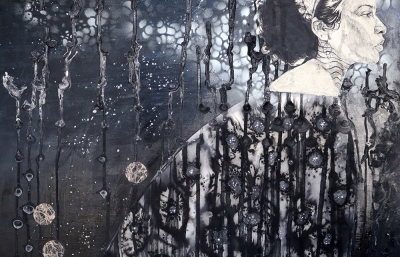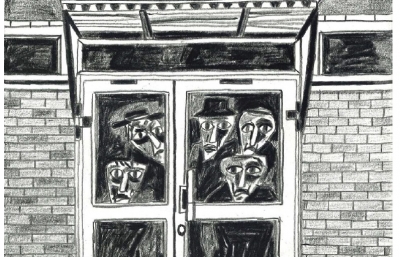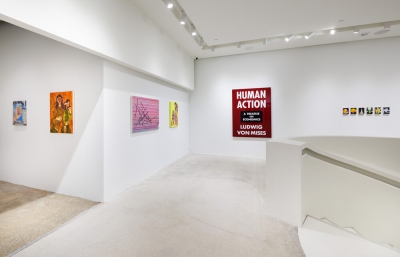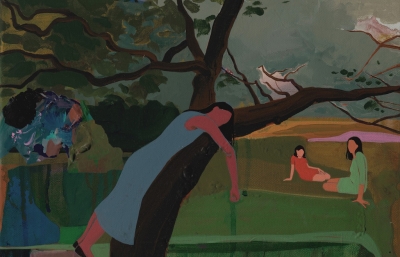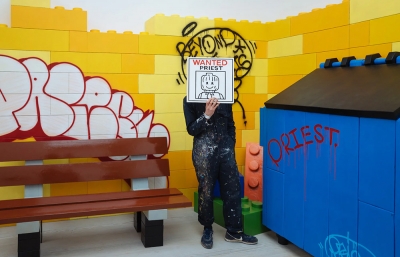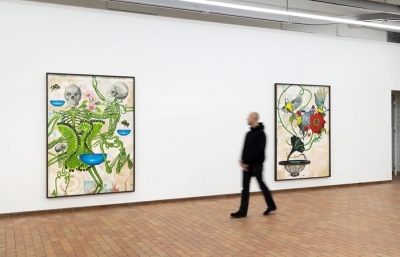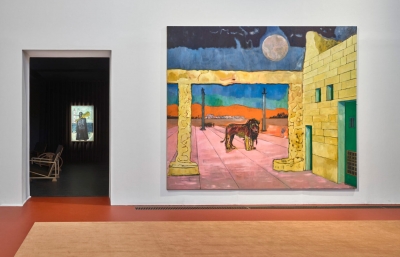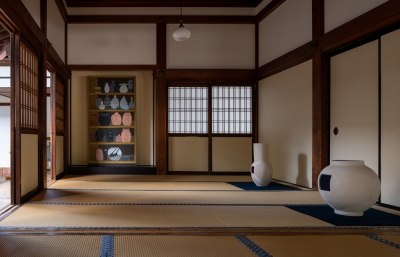For decades, Americans, especially artists, have had a unique curiosity (well, an obsession) with Japanese culture. From comics to fashion, ceramics to underground art, Japan has set the standard for passionate, intricate, creative expression. So imagine our surprise when Japanese-born, Los Angeles-based painter Yu Maeda revealed that it was his move to the US that awakened him to the unique art language of his homeland. Nurtured on American cartoons, music and iconography, Maeda now focuses his work on more traditional Japanese imagery, balancing the flavors of East and West as he savors an exhilarating journey into the world of fine art.
Before a massive warehouse fire destroyed their space in downtown Los Angeles, Superchief Gallery’s Bill Dunleavy sat down with Maeda to discuss the equilibrium in his work, from American horror movies to the Japanese Shinto religion, to individualism and the excitement of returning home to make a new body of work. 
Bill Dunleavy: Where are you from originally, and what brought you to the US?
Yu Maeda: I was born in Kumamoto Prefecture, which is in the south of Japan. After learning design at Kyoto University of Art, I worked in Tokyo for seven years as a commercial animator. Eventually, I got tired of making that kind of work and taking the client’s instructions, and I wanted to create a job for myself.
At the time, I was doing some illustration and doodles for fun and wanted to draw pictures more seriously. I figured I’d quit my job, make a big life change, and try to make it work. I have always been into American film and culture, so I decided to relocate to the US.
What role did American culture play in your life growing up, and in influencing the artist you’ve become today?
American culture, like 1980’s horror and sci-fi films by directors David Cronenberg and Alex Proyas, have always been really influential for me. My parents showed me a lot of American TV growing up instead of Japanese stuff. We watched a lot of The Simpsons and Disney in my childhood. I specifically remember this Disney animation called Silly Symphony: Flowers and Trees, which I had on VHS and watched over and over again. I think that’s the first illustration I remember being inspired by. Later on, I got into South Park, too.
As for illustration and art, things like Rat Fink, and Lowbrow artists, and skate graphics by Jim Phillips were always some of my favorites. Skateboard culture was a big influence on me, even though I’m not good at skating. Musically, I’m into punk and hardcore, mostly UK Punk and ’90’s hardcore, and post-punk like Fugazi. 
But there must be some Japanese cultural influences on you and your work?
It’s funny, I actually really wasn’t interested in Japanese culture until I moved to the United States. Once I was here, I started to get interested in Buddhism, especially its temples, statues, and philosophy. The original Japanese religion of Shinto, more ancient than Buddhism, also interests me a lot. I’ve just started exploring and learning more about Shinto.
In some ways, traditional Japanese culture has started to feel like my own counterculture, because, in Japan, I was brought up on so much American culture, it’s really exciting for me to start learning more about Japan’s history and legacy. As a Japanese person, I feel like I’m in a unique position, considering my parents sheltered me from Japanese influence growing up and only showed me American perspectives. I was a really shy kid, so I didn’t have many friends growing up there, either. My biggest influences from what I study today is that I’m very into animism and the belief that our relationship with nature is sacred and spiritual.
American capitalism affected Japan so much after WWII that I think many Japanese people lost their connection to the cultural ideas of the past. My grandparents were farmers, and I’m from the countryside, so studying animism, Buddhism and Shinto have been helping me understand and appreciate where I come from. Despite all that, I am really against the idea of nationalism, and I enjoy drawing influences from Japanese, American and international culture together. I want to create artwork that is universal.
What is your impression of the US and the art scene here?
American individualism makes me feel comfortable. In Japan, individuality is generally not respected. I really like the art scene in California, and what I’ve seen of America. There are so many great galleries and artists here, and so many different cultures and subcultures to get involved with. People in America are very open-minded, and I enjoy being around so many people who view themselves as individuals. I think it’s good for the vitality of the scene to welcome so many different ideas. 
You started painting when you came to the US. Can you tell me about the trajectory your career has taken as things have gotten more serious?
I’ve lived in California for over six years and I started painting as soon as I moved here. During the first years, I did a lot of work for Japanese companies to make money. It has been my goal to become a full-time artist, and I’ve been able to live on my work for three or four years now. I started posting my work on Instagram and saw good results with that. Before 2010, there was no place for me to get my work out there. Over the years, I’ve done a bunch of commission work for clients like Animal Collective, Desert Daze, Thundercat, and Guerilla Toss.
My first exhibit in LA was a group show at Bergamot Station in 2014, and soon after that, I showed with Defenders of Good Times in Portland at White Owl Social Club. I went to Superchief Gallery in LA for the first time in 2014 to see Lil Kool’s work, and I kept attending the shows. As you probably know, I gave them some stickers and prints of my work, and they offered me a spot in their Annual Mega Group Show for the first time in 2016. About that time, I was also showing some pieces with Giant Robot, and I was getting more refined as a painter with a few years of practice. In 2018, Superchief invited me to be in my first big exhibition in LA, a more focused group show called D3ATH with Homeless Cop and Bonethrower. It was my first time painting a mural, and my first time exhibiting a cohesive body of work.
After performing well in the D3ATH group show, Superchief asked me to do my first solo show, which was in May, 2019. For that, I made 40 or 50 paintings, as well as a 14-foot sculpture, a big mural, and even some of my own animation work. Superchief also published my first book for the show, with all my paintings from 2016–2019.
How was the experience of doing your first big solo show?
I was nervous because the space was huge! Basically, I painted for eight hours a day, almost every day, for nine months. I learned a lot of things through the process of making work for the show, especially identity and what relationship I have with US culture as a Japanese artist. I didn’t want to pretend that I was somehow a part of a counterculture movement like Lowbrow, but, at the same time, I wanted to dig into my own roots and see how I could express myself through self-discovery and art influences. I didn’t realize how important my roots in Japan were before coming here and making work.
My solo show was centered around a large Buddha painting and large wooden sculpture shrine to animism. I also did some experimental hand-painted animations, which is something I look forward to doing in the future. Now, I’m getting ready to move back to Japan for the first time in six years to start working on my next solo show, which will be at Superchief in 2021. 
What are some of the best exhibitions you’ve seen out here in six years, and who are some of your favorite artists working today?
Sarah Sitkin’s Bodysuits exhibition at Superchief Gallery LA was one of my favorites. The Tokyo Pop Underground exhibition that NANZUKA did with Deitch, as well. It was amazing to see Keiichi Tanaami’s work in person for the first time. He is probably my favorite artist. I also love the work of Shinichi Sawada. He’s an outsider artist from Japan who works constantly. Outsider art is my favorite because the artists are motivated purely by love of their craft.
How do you think going back to Japan will affect your style and work?
Studying Japanese culture and history are at the top of the list when I return home. I hope to synthesize my experiences from California and Japan and take my work in a unique direction. Mostly, I am planning to focus and make the next body of work for my solo show, but I hope to do some exploration and travel as well.
Is there any art you’re really excited to check out once you get back to Japan?
Yes, I want to check out the Yokoo Tadanori Museum. He’s a well known psychedelic graphic artist who transitioned into painting and is one of my major inspirations. Definitely want to see the Minzoku-Hakubutsukan in Osaka, which is a cultural anthropology museum with a lot of artifacts from Japan. And of course NANZUKA Underground in Tokyo, one of my favorites.
Stay tuned for Yu Maeda’s solo show with Superchief Gallery in 2021.

